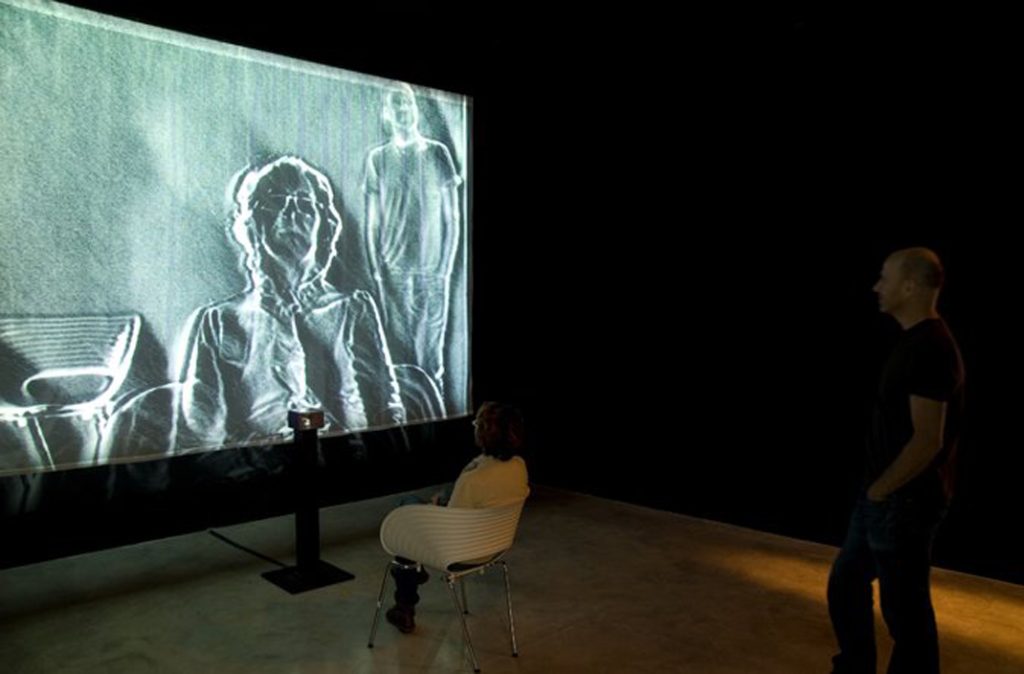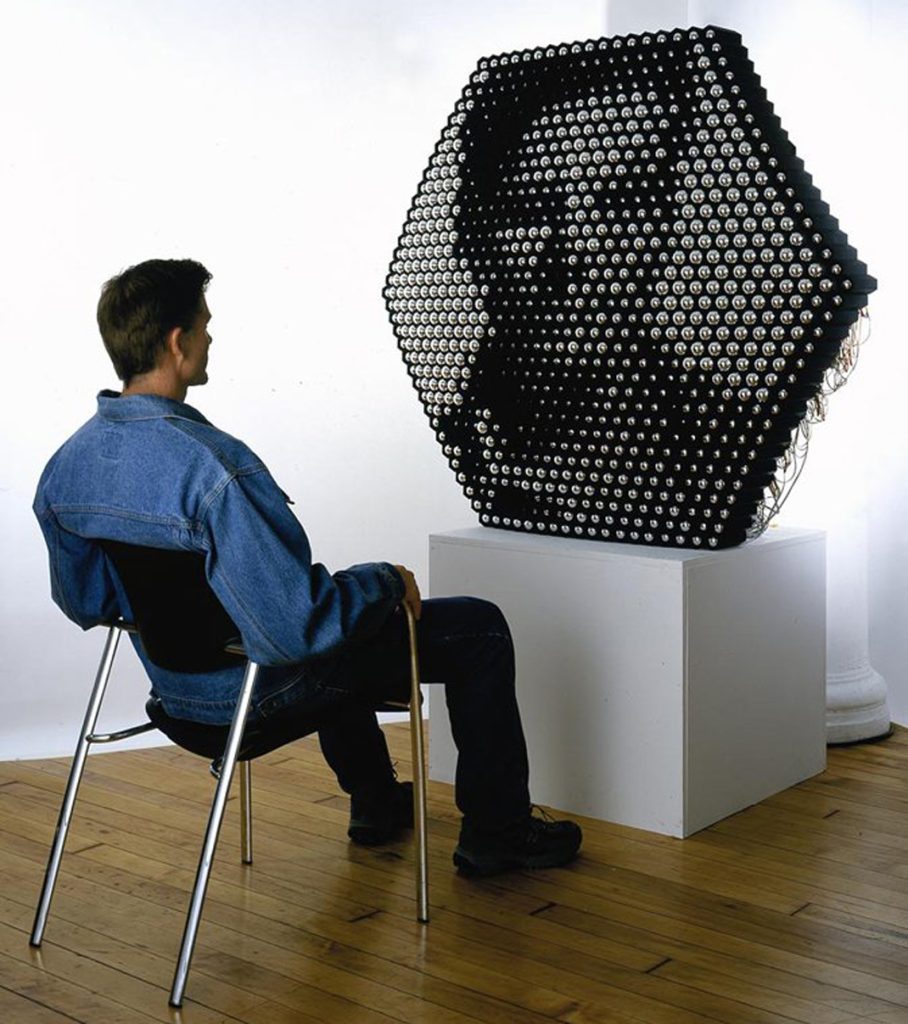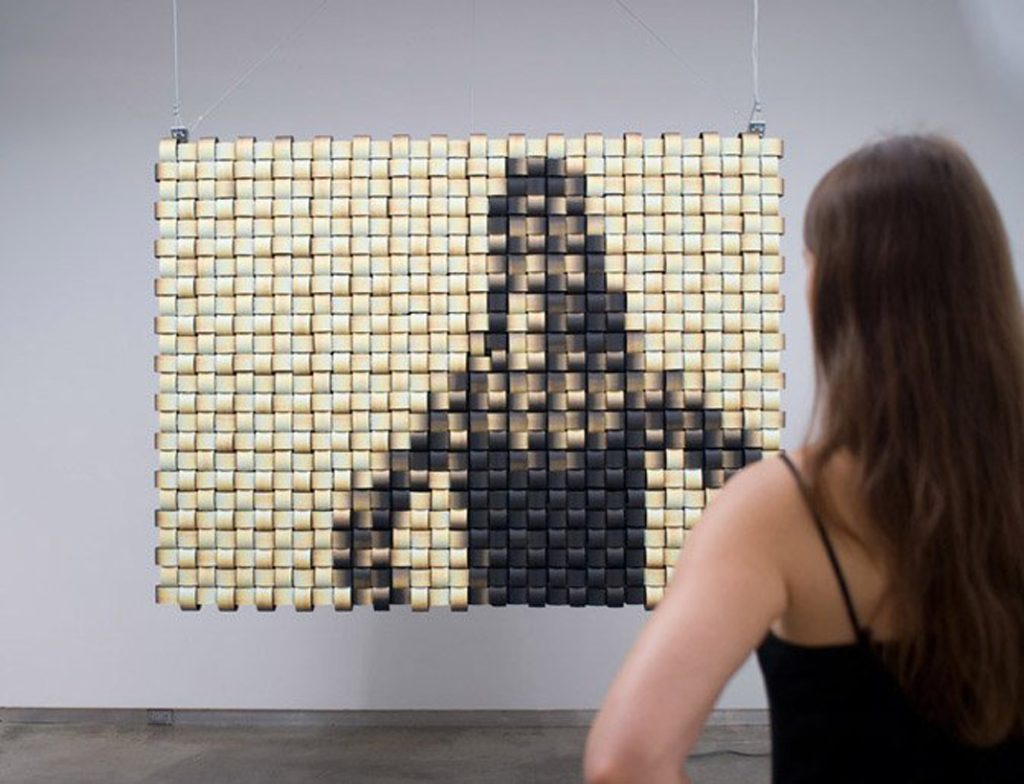All the pieces created by interaction artist and designer Daniel Rozin over the past fifteen years are mirrors that reflect the images of people standing in front of them.
All the pieces created by interaction artist and designer Daniel Rozin over the past fifteen years are mirrors that reflect the images of people standing in front of them. The mirrors are equipped with cameras, motors, and computers. Some are physical, like kinetic sculptures composed of pieces of wood, while others are wholly digital.Born in Israel in 1961, Rozin studied industrial and interactive design at Bezalel Academy of Arts and Design, and worked at Scitex Corporation Ltd. He continued his studies in New York, and currently teaches at ITP, Tisch School of the Arts, New York. He has won numerous awards, and his work has been exhibited all over the world, including in the United States, Korea, Japan, Taiwan, and the Israel Museum. Daniel Rozin came to Israel for the opening of the Decode exhibition, and made time for a short interview. Snow Mirror is essentially a digital work. A camera set in the fore of the mirror captures the image of the viewer, and a projector screens 100 white dots that create the different reflections on a silk screen. The white dots congregate in the brighter areas of the photographed image, and for a single magical moment a sufficient number of dots accumulate on the screen, and the image becomes clear and legible.

The initial idea underlying this work, Rozin says, was to try and examine what is the minimal amount of information required for the human eye to see and recognize an image. There is no color in this piece, and the movement of the dots as they cascade down the screen is very slow, resembling falling snowflakes.Engaging in a limited quantity of ‘raw material’ to create the piece was of great interest to Rozin. “It’s like asking a painter to use the same amount of paint to paint every painting in the world irrespective of how complex and detailed it is”, says Rozin.Another central and important element in Rozin’s work in general, and this piece in particular, is the idea of interaction. “Many people think that the main meaning of interaction is how I operate, influence, and control the computer or machine. It’s true, but only in part. In an interactive process the computer or machine have considerable control and influence on the user’s behavior and actions”, says Rozin, and adds, “In my view, correct interaction is a situation in which how we control the computer’s behavior equals how the computer controls ours”.
Daniel Rozin, Wooden Mirror
Why did you choose mirrors as the theme of your work? “There are a lot of layers in the subject of reflection and the way an image is reflected. It creates a situation whereby we see ourselves exactly as we see others, very realistically, with all the attractive and less attractive details. This situation is significant because it totally contradicts how we see ourselves in our own eyes. Until about a hundred years ago people saw themselves reflected in puddles of water or metal receptacles like pots and pans, and the reflected image was usually unclear and imprecise. For most people the possibility of seeing themselves accurately in a mirror has only existed for a relatively short space of time.In my work I try to show reflections. These reflections are presented at a certain level of abstraction in which you can recognize yourself but can’t see details like wrinkles.

“The choice of mirrors as the theme for my work stems from the fact that we all know how to stand in front of a mirror and the image is reflected in it naturally. The works of many artistic creators deal with content; I want my work to be about the viewer or visitor to an exhibition. The content of my work is you, and as soon as you leave, it’s about another viewer.I start out from a desire to express something. If I had the ability and skill, I’d prefer to draw and sketch. Yet, it was only when I was thirty-seven that I began to think of myself as an artist-creator. For me, what’s fun about creating an interactive piece is that you (the designer) create half of it, and the rest is created by the viewer or user. The piece doesn’t end with my imagination, but with the viewer’s thought that can go beyond what I thought”.For many years Rozin, who studied industrial design before going on to engage in art, found it difficult to define himself as an artist. “At the same time”, he says, “it suits me very much to show my work in an artistic context. Nowadays a lot of art is created in a digital context. Until a few years ago designers didn’t have the tools to create digital works and had to use programmers because they didn’t have the ability to execute their ideas in digital media.”We’re at a transitional stage now and I estimate it will be a few more years before a designer is able to freely create without being dependent on the tools of digital interaction. When that happens, the digital tool will be just like any other, like a chisel or paintbrush. It took video artists at least fifty years of experimentation before they got to where they are now, creating high quality video art. It also took a long time for video art enthusiasts to learn to properly appreciate, understand, and judge video art works. But today it is accessible art. It’s been about fifteen years already, so it’ll take a few more years…”


Man’s dependence on machines is constantly growing. What are the principles of man-machine interaction that should be preserved, and what should we beware of?” When you try to teach technology to people of around fifty, it’s a highly sensitive subject. For many older people anything associated with digital technology immediately erects a kind of barrier. I work with technology a lot, I understand it, and so I don’t flinch from it. By contrast, young people nowadays see an iPhone and instantly know how to operate it, but they also have a high level of expectations and immediately want to know what it can do and what’s new about it.In my view, at this point in time the direction, focus, investment, and weight of computer communications have to be man and not the computer. Fifteen years ago Apple launched a device called Newton that was supposed to recognize the user’s handwriting and ‘understand’ what he wrote. It failed because the computer couldn’t read and understand the handwriting of many users. Years later a similar device called Palm Pilot came onto the market, but the user had to learn how to write so that the computer could understand what he wrote. In other words, man had to adapt himself to the machine. Because the human brain and intuition have changed with technological advances, it’s sometimes easier to teach humans than computers. This situation might change in the future when technology advances and is better able to recognize human handwriting. Great advances are already being made in this direction with voice recognition – the ability to talk to a computer as you would to a person. Despite all the technological advances we should remember that the telephone, which has been in existence for over a hundred years, still facilitates better communication than many computers even though we can’t see the speaker face to face”.
Circles Mirror, 2005
Where do you foresee the field of interaction progressing to?”I teach interaction at NYU. The students in my department studied different subjects during their BA studies, and now they’re studying technology. Some are pulling in artistic directions, but some are psychologists, authors, designers, and their fields of practice are completely different. In our program the aim is to focus on a dream and an idea and attempt to conceive and create all kinds of things that aren’t necessarily functional and it’s not entirely clear what they actually are.Kinect (a motion sensing input device by Microsoft that enables control by means of body movement without touching a remote control or game controller) was launched about eighteen months ago, and students in the department are already using it for their projects. In my view, any technological product will be snatched off the shelves if it has a human touch and correct interaction”.
Daniel Rozin, Works (2002-2008), from Bitforms Gallery
Rozin talks about companies that recruit the most outstanding students from the best universities for their development centers yet don’t have an inkling of what’s happening in the field of interaction because they invest their vast development efforts in things like faster chips for example. According to him, companies that start to think a bit more creatively and bring designers into their development teams, manage to produce attractive products in this field.Have you been approached by commercial companies to turn your artworks into shelf products?”In my first years as an artistic creator I patented code developments, but over time I’ve come to the conclusion that this isn’t where I want to go, that what I’m doing is for intellectual purposes. Perhaps I’m not sufficiently hungry, but right now it’s of less interest to me. When I worked as an industrial designer I made sketches of some of the products being developed by the company I worked for. At a later stage the sketches were sent to the marketing and engineering departments where they were completely changed. Today I design and program my work myself, my compromises are with myself and I’m prepared to live with them. The only person telling me something can’t be done is me.I believe it’s much easier to teach programming to a person who knows how to express himself. The objective is already clear to this kind of person and the only thing that needs to be done is to teach him how to get there. By contrast, in the field of programming there are people with extensive knowledge on how to implement, but who lack creative vision.I’m a great believer in craft, because people can appreciate and understand how an object was made, and its quality can be appreciated as well. In works that are primarily programming, it’s much more difficult for the user to understand the kind of work the programmer has actually done”.In conclusion Rozin says, “There was a great deal of naïveté in my works fifteen years ago, and I was all over the place in those days. There’s something about being naïve and not yet knowing what’s possible and what isn’t. You ask questions that have been asked by many before you and sometimes you get new answers. That’s why I’m also a great believer in ignorance, because sometimes you arrive at surprising places and succeed”.



